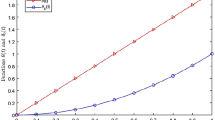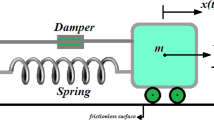Abstract
Nonhomogeneous transmission systems occur in several practical configurations such as nonideally transposed overhead lines, cross-bonded cables, and river crossings of overhead lines. In the past, a compact and efficient representation of nonhomogeneous system (NhS) was only possible in the frequency domain as the chain matrix (matrix transfer function) was used to obtain an equivalent nodal admittance matrix. Time-domain representation of a NhS demands explicit representation of each homogeneous section, thereby not being an efficient solution. This work proposes to represent nonhomogeneous systems using a rational approximation which allows for a compact and accurate time-domain realization. In this approach, we exploit the fact that a NhS can be seen as a particular case of a frequency-dependent network equivalent. The frequency dependence of the NhS is included via the rational modeling of the admittance matrix using the so-called Vector Fitting algorithm. Two test cases are considered to illustrate the gain of the proposed solution. The first one is the modeling of a nonideally transposed transmission line, and the second one is a case of river crossing. To asses the accuracy of the modeling, the results are compared against the ones obtained either using the Numerical Laplace Transform and PSCAD.








Similar content being viewed by others
References
AlFuhaid, A., Oufi, E., & Saied, M. (1998). Application of nonuniform-line theory to the simulation of electromagnetic transients in power systems. International Journal Electric Power and Energy System, 20(3), 225–233.
Ametani, A. (2002). Wave propagation on a nonuniform line and its impedance and admittance. The Science and Engineering Review of Doshisa University, 43(2), 11–23.
Ametani, A., Kasai, Y., & Sawada, J. (1994). Frequency-dependent impedance of vertical conductor and a multiconductor tower model. Proceeding IEE Generation Transmission and Distribution, 141(4), 339–345.
Bode, H. W. (1945). Network analysis and feedback amplifier design. New York: D. Van Nostrand.
Deschrijver, D., Gustavsen, B., & Dhaene, T. (2007). Advancements in iterative methods for rational approximation in the frequency domain, IEEE Transactions on Power Delivery, p. 2006.
Dommel, H. (1992). EMTP theory book. Vancouver: MicroTran Power System Analysis Corporation.
Fernandes, A. B., Neves, W. L. A., Costa, E. G., & Cavalcanti, M. N. (2004). Transmission line shunt conductance from measurements. IEEE Transactions on Power Delivery, 19(2), 722–728.
Gomez, P., Moreno, P., & Naredo, J. (2005). Frequency domain transiente analyis of nonuniform lines with incident field excitation. IEEE Transactions on Power Delivery, 20(3), 2273–2280.
Gustavsen, B. (2002). Rational approximation of frequency dependent admittance matrices. IEEE Transactions on Power Delivery, 17(4), 1093–1098.
Gustavsen, B. (2004). Wide band modeling of power transformers. IEEE Transactions on Power Delivery, 19(1), 414–422.
Gustavsen, B. (2006). Improving the pole relocation properties of vector fitting. IEEE Transactions on Power Delivery, 21(3), 1587–1592.
Gustavsen, B. (2008). Fast passivity enforcement for pole-residue models by perturbation of residue matrix eigenvalues. IEEE Transactions on Power Delivery, 23(3), 2278–2285.
Gustavsen, B. (2014). Rational modeling of multiport systems via a symmetry and passivity preserving mode-revealing transformation. IEEE Transactions on Power Delivery, 29(1), 199–206.
Gustavsen, B., & Heitz, C. (2008). Modal vector fitting: A tool for generating rational models of high accuracy with arbitrary terminal conditions. IEEE Transactions on Advanced Packaging, 31(4), 664–672.
Gustavsen, B., & Semlyen, A. (1999). Rational approximation of frequency domain responses by vector fitting. IEEE Transactions on Power Delivery, 14(3), 1052–1061.
Gustavsen, B., & Semlyen, A. (2009). Admittance-based modeling of transmission lines by a folded line equivalent. IEEE Transactions on Power Delivery, 24(1), 231–239.
Gutierrez, R., Moreno, P., Naredo, J., Bermudez, J.-L., Paolone, M., Nucci, C., et al. (2004). Nonuniform transmission tower model for lightning transient studies. IEEE Transactions on Power Delivery, 19(2), 490–496.
Lima, A. C. S., & Portela, C. (2007). Inclusion of frequency-dependent soil parameters in transmission-line modeling. IEEE Transactions on Power Delivery, 22(1), 481–491.
Martins, T. F. R. D., Lima, A. C. S., & Carneiro, S. Jr., (2005). Effect of impedance approximate formulae on frequency dependence realization. In Proceeding of IPST’05 - International on Power System Transients Conference, Montreal.
Morched, A., Gustavsen, B., & Tartibi, M. (1999). A universal model for accurate calculation of electromagnetic transients on overhead lines and underground cables. IEEE Transactions on Power Delivery, 14(3), 1032–1038.
Nguyen, H., Dommel, H., & Marti, J. (1997). Modeling of single-phase nonuniform transmission lines in electromagnetic transient simulations. IEEE Transactions on Power Delivery, 12, 916–921.
Noda, T. (2005). Identification of a multiphase network equivalent for electromagnetic transient calculations using partitioned frequency response. IEEE Transactions on Power Delivery, 20(2), 1134–1142.
Oufi, E., AlFuhaid, A., & Saied, M. (1994). Transient analysis of lossless single-phase nonuniform transmission lines. IEEE Transactions on Power Delivery, 9, 1694–1700.
Ramirez, A., Semlyen, A., & Iravani, R. (2003). Modeling nonuniform transmission lines for time domain simulation of electromagnetic transients. IEEE Transactions on Power Delivery, 18(3), 968–974.
Salari Filho, J., & Portela, C. (2007). A methodology for electromagnetic transients calculation-an application for the calculation of lightning propagation in transmission lines. IEEE Transactions on Power Delivery, 22(01), 527–536.
Schelkunoff, S. (1943). Electromagnetic waves. New York: D. Van Nostrand Co.
Semlyen, A. (2003). Some frequency domain aspects of wave propagation on nonuniform lines. IEEE Tranactions on Power Delivery, 18(1), 315–322.
Semlyen, A., & Dabuleanu, A. (1975). Fast and accurate switching transient calculations on transmission lines with ground return using recursive convolutions. IEEE Transactions on Power Apparatus and Systems, 94, 561–571.
Semlyen, A., & Gustavsen, B. (2009). A half-size singularity test matrix for fast and reliable passivity assessment of rational models. IEEE Transactions on Power Delivery, 24(1), 345–351.
Tavares, M., Pissolato, J., & Portela, C. (1999). New multiphase mode domain transmission line model. International Journal of Electrical Power and Energy Systems, 21(4), 585–601.
Wedepohl, L. (1997). The theory of natural modes in multiconductor transmission systems, the University of British Columbia. Rep: Tech.
Wedepohl, L., & Indulkar, C. (1974). Wave propagation in nonhomogeneous systems. Properties of the chain matrix. Proceedings of the IEE, 121(9), 997.
Wedepohl, L., & Indulkar, C. (1975). Switching overvoltages in short crossbonded cable systems using the Fourier transform. Proceedings of IEE, 122(11), 1217–1221.
Wedepohl, L., & Indulkar, C. (1979). Switching overvoltages in long crossbonded cable systems using the Fourier transform. IEEE Transactions on PAS, PAS–98, 1476–1480.
Author information
Authors and Affiliations
Corresponding author
Appendices
Appendix 1: Overhead Line Conductor Data
For the 500-kV lines, each phase has a four-conductor bundle with a 0.5-m spacing, phase conductors are Rail, and ground wires are 3/8” EHS. The coordinates for the centers of phase conductors bundle and for the ground wires are given as follows:
Appendix 2: State Space Formulation
For a first-order proper pole-residue model with input \(u\) and output \(y\), we may write in the frequency domain:
in the time domain (28) can be written as
a discrete time model of (29) can be obtained using either trapezoidal rule integration or recursive convolution. The expressions are shown in (30).
If the trapezoidal integration rule is applied, then the coefficients \(\alpha \), \(\lambda \) and \(\mu \) are given by
and in the case where recursive convolutions are used, we have
Rights and permissions
About this article
Cite this article
Lima, A.C.S. Rational Modeling of Nonhomogeneous Systems. J Control Autom Electr Syst 26, 180–189 (2015). https://doi.org/10.1007/s40313-014-0162-2
Received:
Revised:
Accepted:
Published:
Issue Date:
DOI: https://doi.org/10.1007/s40313-014-0162-2




